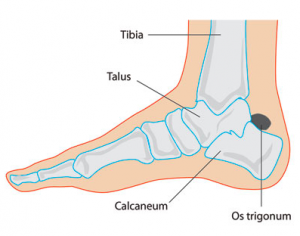What causes Os Trigonum syndrome?
 The os trigonum bone is present at birth and may be in one or both feet. Os trigonum syndrome describes the irritation to the soft tissue structures around the os trigonum bone the bone and tissues are wedged between the calcaneus (heel bone), talus (the ankle bone above the heel bone) and the bottom of the tibia (shin bone). This often occurs following either injury or overuse (repetitively pointing the foot downwards) and produces painful symptoms. Any injury to the back of the ankle and any activity that points the toes downwards can lead to os trigonum syndrome. These can include:
The os trigonum bone is present at birth and may be in one or both feet. Os trigonum syndrome describes the irritation to the soft tissue structures around the os trigonum bone the bone and tissues are wedged between the calcaneus (heel bone), talus (the ankle bone above the heel bone) and the bottom of the tibia (shin bone). This often occurs following either injury or overuse (repetitively pointing the foot downwards) and produces painful symptoms. Any injury to the back of the ankle and any activity that points the toes downwards can lead to os trigonum syndrome. These can include:
- Downhill running
- Ballet
- Soccer
- Ankle sprain injuries
What are the symptoms?
Symptoms can include:- Pain and tenderness at the back of the ankle
- Swelling
- Stiffness/weakness in the area
- Pain is exacerbated by pointing the toes downwards or standing on the toes
- Subsequent inflammation and damage to other soft tissue structures at the back of the heel ankle (e.g. possible bursitis, Achilles tendonitis, ligament tenderness)
How is it treated?
Before commencing treatment, the os trigonum syndrome must be diagnostically confirmed as there it shares symptoms with multiple other conditions that present at the back of the heel and ankle. Treatment begins with alleviating the initial painful symptoms by following the PRICE principles (protection, rest, ice, compression, elevation). Treatment then focuses on allowing the damaged tissues to heal without aggravating and flaring up the area. This can include:- Orthotics to stabilise the foot and reduce tension away from the back of the ankle
- Footwear assessment to ensure that the shoes are helping and not hindering the problem
- Physical therapy to stretch and strengthen any muscles that may be contributing to ongoing irritation and pain
- Brace or boot to immobilize the ankle








